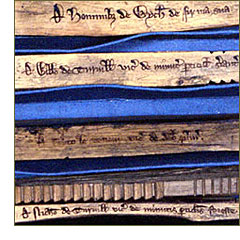
A tally stick is "a long wooden stick used as a receipt." When money was paid in, a stick was inscribed and marked with combinations of notches representing the sum of money paid, the size of the cut corresponding to the size of the sum. The stick was then split in two, the larger piece (the stock) going to the payer, and the smaller piece being kept by the payee. When the books were audited the official would have been able to produce the stick with exactly matched the tip, and the stick was then surrendered to the Exchequer.
Tallies provide the earliest form of bookkeeping. They were used in England by the Royal Exchequer from about the twelfth century onward. Since the notches for the sums were cut right through both pieces and since no stick splits in an even manner, the method was virtually foolproof against forgery. They were used by the sheriff to collect taxes and to remit them to the king. They were also used by private individuals and institutions, to register debts, record fines, collect rents, enter payments for services rendered, and so forth. By the thirteenth century, the financial market for tallies was sufficiently sophisticated that they could be bought, sold, or discounted.
"Tallies were ... a sophisticated and practical record of numbers. They were more convenient to keep and store than parchments, less complex to make, and no easier to forge.... Of the millions of medieval tallies made, only a few hundred survive."
. In 1724, treasury officials commanded that tallies no longer be used, but it was not until 1834, with the reform acts and the abolition of the office of the Receipt of the Exchequer, that a huge bonfire of the then-obsolete medieval tally sticks was held. Started in a stove stuffed full of sticks in the House of Lords, the fire quickly got out of control, spreading to the paneling, and burning down both the Palace of Westminster and the Houses of Parliament.
The evolution of money technologies originates with the tally stick. From tally stick comes the modern word "stock," meaning a financial certificate and deriving from the use of the Middle English for the stick. The piece retained by the bank was called the "foil." The holder of the stock was said to be the "stockholder" and owned "bank stock." A written certificate presented for remittance and checked against its security later became a "check."
According to legend, Wall Street was founded in its present location because of the presence there of an enormous chestnut tree, said to be plentiful enough to supply enough tally sticks for the emerging American stock market.
 |
| http://www.freeread.com/fiat-money-of-the-past-part-3 |
I learned something new today! :0)
Neat! I think I've heard the term, but never knew anything about it.
ReplyDeleteI guess it was a good way to keep tabs on items sold when people couldn't read!
DeleteI have heard people say tallie up the bill or the damages etc but had no idea where the term came from :))
ReplyDeleteSo many words we use today that we don't really know their original meaning - this one was really interesting!
DeleteThe ol cowmen and the Cowman all had little books they called tally books. They were mostly chock full of numbers...head counts & weights. I love learning the origins of words. Thank you for a really interesting post.
ReplyDeleteGlad you liked it, Brighid! I guess it really must have been difficult to keep an accurate account of thousands of heads of cattle. Must have been a awesome sight at the stockyards.
Delete